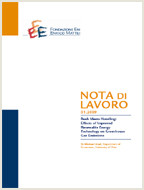Path Dependence, Institutions and the Density of Economic Activities: Evidence from Italian Cities

11.09.2010
Marco Percoco
O18, R12
Path dependence, Urban development, Geography, Institutions, Firm density
Economy and Society
Gianmarco I.P. Ottaviano
In recent years a growing body of literature has begun to consider the possible presence of path dependence in the development processes of countries. This phenomenon has always been recognized in regional and urban studies because the path of development almost naturally follows a history-dependent spatial diffusion influenced by both physical geography and the quality of institutions. In this paper, I consider the case of firm concentration in Italy and its impact on local development. A large and growing literature has argued in favour of persisting effects of past institutions on current outcomes. Hence, in order to identify the impact of firm density on income, I use instruments from the history of a set of Italian cities: namely the presence of a university and status as a free-city state in the Early Middle Ages. I first show that those two variables had an important effect on the process of urban development between 1300 and 1861, together with favourable geographic conditions. Then, when I use these instruments to predict firm density, I find that the elasticity of income to firm density is close to 0.1. This result is interpreted as providing evidence of the historical roots of agglomeration economies in Italy.
